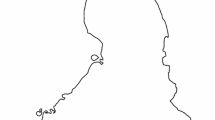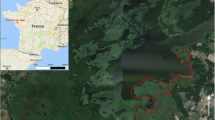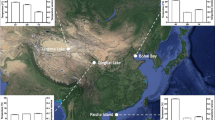Summary
In western Finland, yearly median laying dates of Tengmalm's owls varied from 14 March to 27 April during 1973–1989 and were negatively correlated with the winter densities of voles. Yearly mean clutch sizes varied from 4.0 to 6.7 and were more closely related to the spring than to the winter densities of voles. The yearly mean clutch size decreased with yearly median laying date. The 3-year vole population cycle is typical of the study area. The start of egg-laying was earliest in the peak phase of the cycle (median laying date 22 March), when vole numbers are high during egg-laying, but decline rapidly to low numbers in the next autumn or winter. In the increase phase (1 April) vole abundances are moderate at the time of laying, but increase to a peak in the next autumn or winter. In the low phase (15 April) voles are scarce in spring and in the preceding winter, starting to increase in late summer. Clutch size and female body mass were independent of laying date in the low phase, decreased slowly but significantly in the increase phase, and declined abruptly in the peak phase. These trends also held when the effects of territory quality, female age and male age were ruled out. When comparing the same laying periods, clutch sizes were significantly larger in the increase than in other phases of the cycle, but there was no difference between the peak and low phases. Supplementary feeding prior to and during egg-laying increased clutch size independent of laying date. These results agreed with the “income” model (the rate of energy supply during laying determines clutch size). Tengmalm's owls invest most in a clutch in the increase phase, as the reproductive value of eggs is largest because of high survival of yearlings. A high reproductive effort may be adaptive during this phase, because the availability of voles is predictable during the laying period.
Similar content being viewed by others
References
Angelstam P, Lindström E, Widen P (1985) Synchronous shortterm population fluctuations of some birds and mammals in Fennoscandia — occurrence and distribution. Holarct Ecol 8:285–298
Arcese P, Smith JNM (1988) Effects of population density and supplemental food on reproduction in song sparrows. J Anim Ecol 57:119–136
Daan S, Dijkstra C (1988) Date of birth and reproductive value of kestrel eggs: on the significance of early breeding. In: Dijkstra C, Reproductive tactics in the kestrel Falco tinnunculus. Unpubl Ph D thesis, Dept Zool, Univ Groningen, The Netherlands, pp 85–114
Daan S, Dijkstra C, Drent R, Meijer T (1989) Food supply and the annual timing of avian reproduction. Proc Int Ornith Congr 19:392–407
Davies NB, Lundberg A (1985) The influence of food on time budgets and timing of breeding in the Dunnock Prunella modularis. Ibis 127:100–110
Dijkstra C, Daan S, Meijer T, Cavè AJ, Foppen RPB (1988) Daily and seasonal variations in body mass of the kestrel in relation to food availability and reproduction. Ardea 76:127–140
Drent R, Daan S (1980) The prudent parent: energetic adjustments in avian breeding. Ardea 68:225–252
Finerty JP (1980) The population ecology of cycles in small mammals. Mathematical theory and biological fact. Yale Univ Press, New Haven and London
Glutz von Blotzheim UN, Bauer KM (1980) Handbuch der Vögel Mitteleuropas, Vol 9. Akademische Verlagsgesellschaft, Wiesbaden
Goodman D (1979) Regulating reproductive effort in a changing environment. Am Nat 113:735–748
Haartman L von (1971) Population dynamics. In: Farner D, King JR (eds) Avian biology. Academic Press, New York, pp 391–459
Hansson L (1972) Evaluation of the small quadrate method of censusing small mammals. Ann Zool Fenn 9:184–190
Hansson L (1984) Winter reproduction of small mammals in relation to food conditions and population dynamics. Bull Carn Mus Nat Hist 10:225–234
Hansson L, Henttonen H (1985) Gradients in density variations of small rodents: the importance of latitude and snow cover. Oecologia 67:394–402
Hansson L, Henttonen H (1988) Rodent dynamics as community process. Trends Ecol Evol 3:195–200
Hansson L, Hoffmeyer I (1973) Snap and live trap efficiency for south Scandinavian small mammals. Oikos 24:477–478
Hirons CJM, Hardy AR, Stanley PI (1984) Body weight, gonad development and moult in the Tawny owl (Strix aluco). J Zool Lond 202:145–164
Hirschfield MF, Tinkle DW (1975) Natural selection and the evolution of reproductive effort. Proc Nat Acad Sci USA 72:2227–2231
IlmatieteenIaitos (1972–1989) Kuukausikatsaus Suomen ilmastoon. Marras-huhtikuu. Helsinki
Keith LB (1963) Wildlife's ten-year cycle. Univ Wisconsin Press, Madison
Klomp H (1970) The determination of clutch size in birds. A review. Ardea 58:1–121
Korpimäki E (1981) On the ecology and biology of Tengmalm's owl (Aegolius funereus) in Southern Ostrobothnia and Suomenselkä, western Finland. Acta Univ Oul A 118. Biol 13:1–84
Korpimäki E (1986a) Seasonal changes in the food of Tengmalm's owl Aegolius funereus in western Finland. Ann Zool Fenn 23:339–344
Korpimäki E (1986b) Predation causing synchronous decline phases in microtine and shrew populations in western Finland. Oikos 46:124–127
Korpimäki E (1987a) Timing of breeding of Tengmalm's Owl Aegolius funereus in relation to vole dynamics in western Finland. Ibis 129:58–68
Korpimäki E (1987b) Clutch size, breeding success and brood size experiments in Tengmalm's Owl Aegolius funereus: a test of hypotheses. Ornis Scand 18:277–284
Korpimäki E (1987c) Selection for nest-hole shift and tactics of breeding dispersal in Tengmalm's owl Aegolius funereus. J Anim Ecol 56:185–196
Korpimäki E (1988a) Diet of breeding Tengmalm's Owls Aegolius funereus: long-term changes and year-to-year variation under cyclic food conditions. Ornis Fenn 65:21–30
Korpimäki E (1988b) Effects of territory quality on occupancy, breeding performance and breeding dispersal in Tengmalm's owl. J Anim Ecol 57:97–108
Korpimäki E (1988c) Effects of age on breeding performance of Tengmalm's Owl Aegolius funereus in western Finland. Ornis Scand 19:21–26
Korpimäki E (1989) Breeding performance of Tengmalm's Owl Aegolius funereus: effects of supplementary feeding in a peak vole year. Ibis 131:51–56
Korpimäki E (1990a) Body mass of breeding Tengmalm's Owls Aegolius funereus: seasonal, between-year, site and age-related variation. Ornis Scand 21:169–178
Korpimäki E (1990b) Low repeatability of laying date and clutch size in Tengmalm's Owl: an adaptation to fluctuating food conditions. Ornis Scand 21 (in press)
Korpimäki E, Lagerström M (1988) Survival and natal dispersal of fledglings of Tengmalm's owl in relation to fluctuating food conditions and hatching date. J Anim Ecol 57:433–441
Korpimäki E, Norrdahl K (1989) Avian predation on mustelids in Europe 2: impact on small mustelid and microtine dynamics —a hypothesis. Oikos 55:273–280
Lack D (1968) Ecological adaptations for breeding in birds. Methuen, London
Meijer T, Daan S, Dijkstra C (1988) Female condition and reproduction: effects of food manipulation in free-living and captive kestrels. Ardea 76:141–154
Murphy EC, Haukioja E (1986) Clutch size in nidicolous birds. In: Johnston RF (ed) Current Ornithology, vol. 4. Plenum Press, New York, pp 141–180
Myllymäki A (1977) Demographic mechanism in the fluctuating populations of the Field Vole Microtus agrestis. Oikos 28:468–493
Neuvonen S (1988) Interactions between geometrid and microtine cycles in northern Fennoscandia. Oikos 51:393–397
Newton I (1979) Population ecology of raptors. Poyser, Berkhamsted
Newton I (1986) The Sparrowhawk. Poyser, Calton
Newton I, Marquiss M (1984) Seasonal trends in the breeding performance of sparrowhawks. J Anim Ecol 53:809–829
Newton I, Marquiss M, Village A (1983) Weights, breeding, and survival in European Sparrowhawks. Auk 100:344–354
Perrins CM (1970) The timing of bird's breeding seasons. Ibis 112:242–255
Pietiäinen H (1988) Breeding season quality, age, and the effect of experience on the reproductive success of the Ural Owl (Strix uralensis). Auk 105:316–324
Village A (1986) Breeding performance of kestrels at Eskdalemuir, south Scotland. J Zool Lond 208:367–378
Author information
Authors and Affiliations
Rights and permissions
About this article
Cite this article
Korpimäki, E., Hakkarainen, H. Fluctuating food supply affects the clutch size of Tengmalm's owl independent of laying date. Oecologia 85, 543–552 (1991). https://doi.org/10.1007/BF00323767
Received:
Accepted:
Issue Date:
DOI: https://doi.org/10.1007/BF00323767




